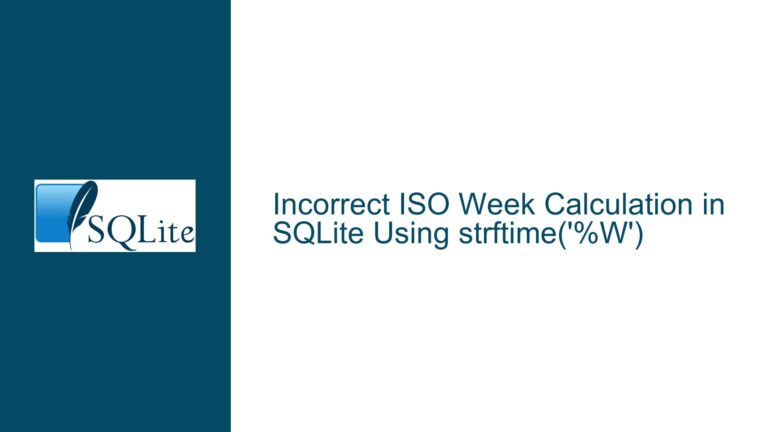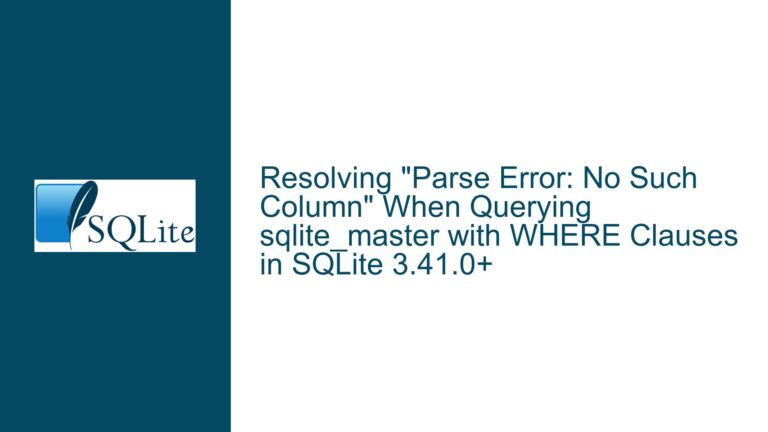Segmentation Fault in FTS5 Custom Auxiliary Function Without Query
Issue Overview: Segmentation Fault in FTS5 Custom Auxiliary Function Without Query
When working with SQLite’s FTS5 extension, particularly with custom auxiliary functions, a segmentation fault (SEGV) can occur under specific conditions. This issue arises when a custom auxiliary function is invoked on an FTS5 table without a full-text query in the SQL statement. For example, executing a query like SELECT function(search) FROM search; where function is a custom auxiliary function and search is an FTS5 table, can lead to a segmentation fault. This fault specifically manifests when the custom function attempts to call certain FTS5 API methods such as xRowid or xQueryPhrase. These methods dereference a NULL pointer when no query is present in the SQL statement, causing the program to crash.
The segmentation fault is particularly problematic because it occurs in a scenario where the developer is attempting to perform a seemingly innocuous operation: determining the number of rows in the FTS5 table. The standard approach, SELECT count(*) FROM search, can be slow, especially with large datasets like the Enron corpus. As a result, developers might opt for a more direct approach using the FTS5 API to retrieve the row count instantaneously. However, this approach can inadvertently trigger the segmentation fault due to the absence of a query in the SQL statement.
The issue is further complicated by the behavior of other FTS5 API methods in the same context. While xRowid and xQueryPhrase fail with a segmentation fault, other methods like xColumnText continue to function, albeit with unexpected results. Specifically, xColumnText returns data from the row with rowid == 1, which might not be the intended behavior. This inconsistency in API behavior underscores the importance of understanding the nuances of the FTS5 extension and the conditions under which certain API methods can be safely invoked.
Possible Causes: NULL Pointer Dereference in FTS5 API Methods
The segmentation fault in this scenario is primarily caused by a NULL pointer dereference within the FTS5 API. When a custom auxiliary function is called without a full-text query, the internal state of the FTS5 extension is not properly initialized for certain API methods. Specifically, the methods xRowid and xQueryPhrase rely on the presence of a query to set up the necessary data structures. When no query is provided, these methods attempt to dereference pointers that are NULL, leading to a segmentation fault.
The root cause of this issue lies in the way the FTS5 extension handles the absence of a query. In a typical full-text search scenario, the FTS5 extension expects a query to be present, as it uses the query to determine which rows to process and how to interact with the auxiliary functions. When no query is provided, the extension fails to initialize the required data structures, leaving certain pointers uninitialized or set to NULL. This oversight in the FTS5 extension’s handling of query-less SQL statements is what ultimately leads to the segmentation fault.
Another contributing factor is the behavior of the xColumnText method, which does not exhibit the same issue. This method continues to function even in the absence of a query, returning data from the row with rowid == 1. This behavior suggests that the xColumnText method does not rely on the same internal data structures as xRowid and xQueryPhrase, or that it has a different mechanism for handling the absence of a query. This inconsistency in API behavior highlights the need for a more robust handling of query-less SQL statements within the FTS5 extension.
The issue was ultimately fixed in the SQLite source code with the check-in 56d265f9. This fix addresses the NULL pointer dereference by ensuring that the necessary data structures are properly initialized even when no query is present. However, the fix does not address the behavior of xColumnText, which continues to return data from the row with rowid == 1. This suggests that while the immediate issue of the segmentation fault has been resolved, there may still be room for improvement in the FTS5 extension’s handling of query-less SQL statements.
Troubleshooting Steps, Solutions & Fixes: Resolving Segmentation Faults in FTS5 Custom Auxiliary Functions
To resolve the segmentation fault issue in FTS5 custom auxiliary functions, developers should follow a series of troubleshooting steps and apply the appropriate fixes. The first step is to ensure that the SQLite library being used includes the fix from check-in 56d265f9. This fix addresses the NULL pointer dereference issue by properly initializing the necessary data structures even when no query is present. Developers should update their SQLite library to a version that includes this fix to prevent the segmentation fault from occurring.
If updating the SQLite library is not immediately feasible, developers can implement a workaround by ensuring that a query is always present when invoking custom auxiliary functions. This can be achieved by modifying the SQL statement to include a dummy query that does not affect the results. For example, instead of executing SELECT function(search) FROM search;, developers can execute SELECT function(search) FROM search WHERE search MATCH '*';. This dummy query ensures that the FTS5 extension initializes the necessary data structures, preventing the NULL pointer dereference.
Another approach is to avoid using the FTS5 API methods that are prone to segmentation faults in query-less scenarios. Instead of relying on xRowid or xQueryPhrase, developers can use alternative methods that do not exhibit the same issue. For example, the xColumnText method can be used to retrieve data from the FTS5 table, although developers should be aware that this method returns data from the row with rowid == 1 in the absence of a query. This behavior may not be suitable for all use cases, so developers should carefully consider the implications of using this method.
In cases where the goal is to determine the number of rows in the FTS5 table, developers should consider using the standard SELECT count(*) FROM search query, despite its potential performance drawbacks. While this query may be slower, it is a reliable and well-tested method for retrieving the row count. If performance is a concern, developers can explore other optimization techniques, such as maintaining a separate row count table or using triggers to keep the row count up to date.
For developers who need to use custom auxiliary functions in query-less scenarios, it is important to thoroughly test the behavior of these functions and the FTS5 API methods they invoke. This testing should include scenarios with and without queries to ensure that the functions behave as expected in all cases. Developers should also monitor the SQLite release notes and updates to stay informed about any changes or fixes related to the FTS5 extension.
In conclusion, the segmentation fault issue in FTS5 custom auxiliary functions can be resolved by updating the SQLite library to include the fix from check-in 56d265f9, implementing workarounds to ensure that a query is always present, and avoiding the use of FTS5 API methods that are prone to segmentation faults in query-less scenarios. By following these troubleshooting steps and applying the appropriate fixes, developers can prevent segmentation faults and ensure the reliable operation of their FTS5 custom auxiliary functions.






